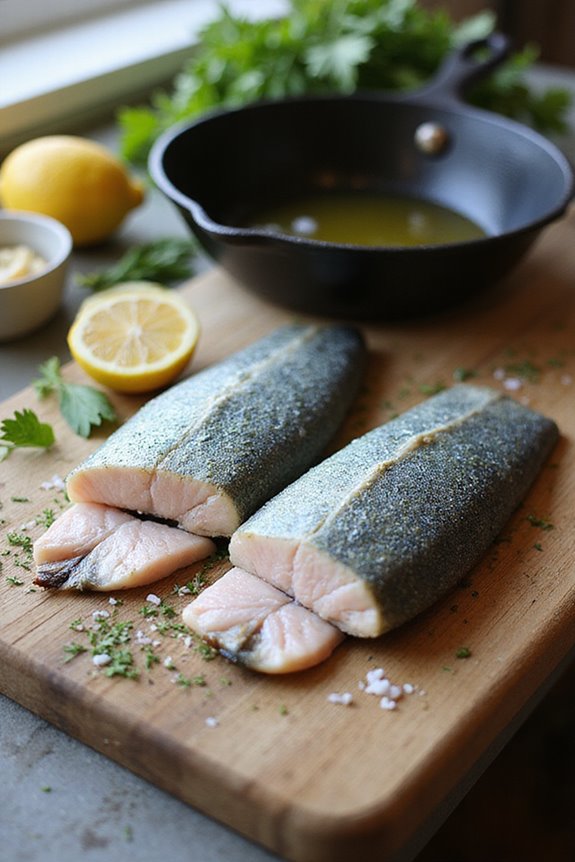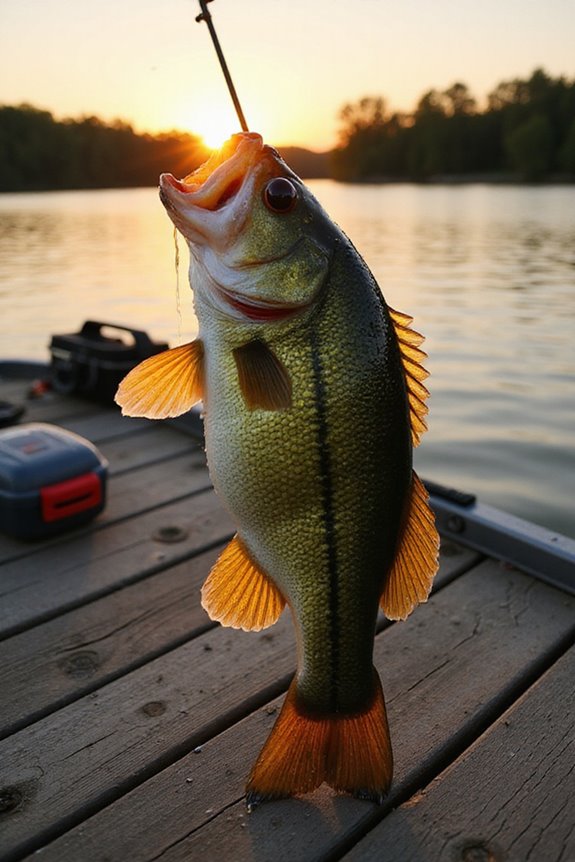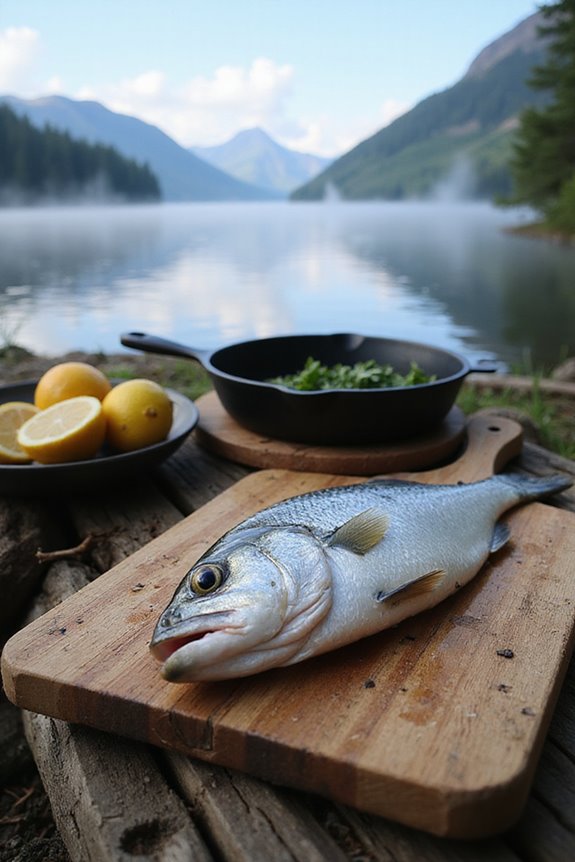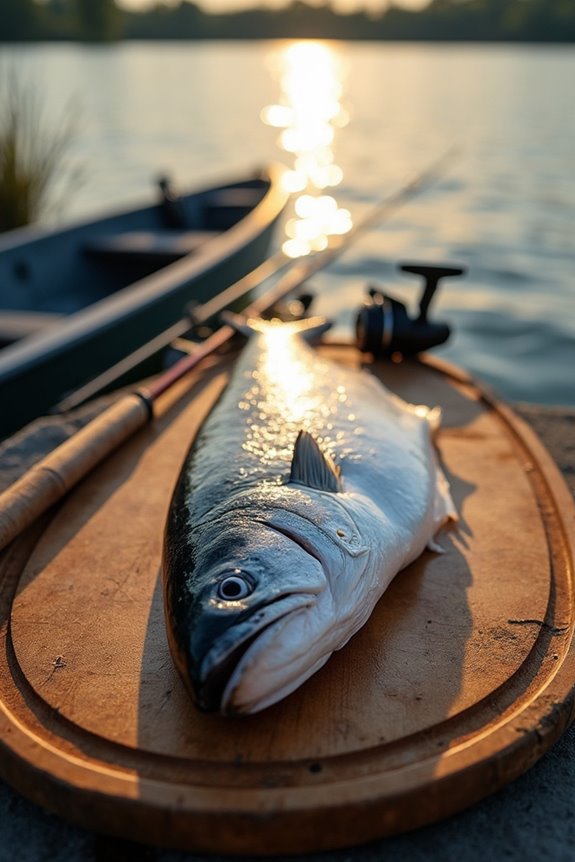To cook mahi mahi in the oven, start by selecting fresh fillets with a light pink to grayish color and a firm texture. Preheat your oven to 400°F (204°C) and grease a baking dish. Season the fillets with olive oil, garlic powder, and smoked paprika. Bake for 15-20 minutes, checking doneness at 145°F. Let the fish rest briefly before serving. For delicious pairings and storage tips, explore the details of enhancing your mahi mahi dish.
Key Takeaways
- Preheat your oven to 400°F (204°C) and prepare a greased baking dish for the fillets.
- Season mahi mahi with olive oil, garlic powder, smoked paprika, and citrus zest for enhanced flavor.
- Arrange fillets in a single layer, ensuring good spacing for even cooking.
- Bake until the internal temperature reaches 145°F (63°C), checking for opaque, flaky flesh.
- Let the fish rest briefly before serving with fresh fruit salsa or roasted vegetables.
Selecting the Right Mahi Mahi Fillets
When it comes to selecting the right mahi mahi fillets, freshness is essential. I always look for fillets with a light pink to grayish color, which indicates quality. The skin should show bright colors if you’re opting for skin-on cuts. Firmness is vital; when pressed gently, the fillet should bounce back. Avoid any that feel mushy. Smelling the fillet is also important; I prefer a clean sea aroma without strong fishy odors. For sourcing tips, I recommend choosing fillets from certified sustainable fishmongers. Check for transparent labeling on catch dates to confirm freshness factors are met. Always handle fillets gently and keep them chilled until you’re ready to cook for the best results. Consider using biodegradable fishing lines when catching your own mahi mahi to reduce plastic pollution in our oceans.
Essential Seasonings and Marinades
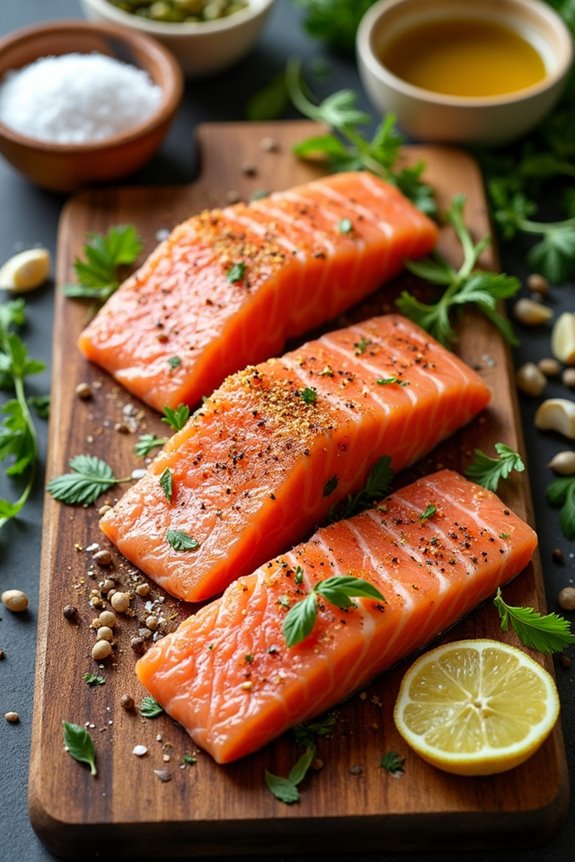
To enhance the natural flavor of mahi mahi, I recommend using a variety of seasonings and marinades that complement its mild taste. Essential herbs like thyme and garlic powder can create aromatic bases, while bold spices such as cayenne pepper and cumin can lend depth. For a zesty twist, incorporate citrus zest from lemons or limes to brighten the dish. Butter blends infused with garlic and paprika add richness and flavor. When choosing seasoning ratios, consider balancing salt with seafood seasoning blends like Old Bay for complexity. You might also try marinade types that include olive oil and citrus juice, ensuring the fish stays moist. Just as with multi-jointed designs in fishing lures, the combination of different seasonings creates a more natural and attractive result. Employ blackening techniques for a crispy, flavorful crust that makes each bite memorable.
Preparing Your Oven and Baking Dish
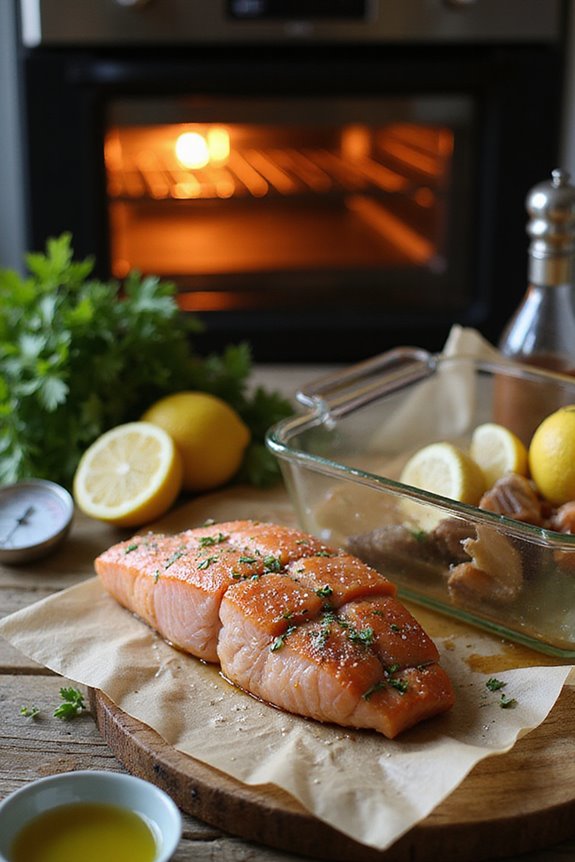
Preparing your oven and baking dish is essential for achieving perfectly cooked mahi mahi. First, preheat your oven to 400°F (204°C). This temperature guarantees even cooking and saves time. I recommend using a reliable oven thermometer to confirm the accuracy, as some dials can be misleading. While the oven preheats, select a baking dish that’s large enough to hold your mahi mahi fillets in a single layer. A 9×13-inch dish works well. Lightly grease the dish with oil or butter to prevent sticking. If desired, line the dish with parchment paper for easier cleanup. Make sure you pat your fish dry before placing it in the dish, as this promotes better browning and seasoning adherence. Unlike feeding aquarium fish with moisture-proof technology that prevents food clumping, cooking fish requires a dry environment for proper browning.
Baking Techniques for Perfect Mahi Mahi
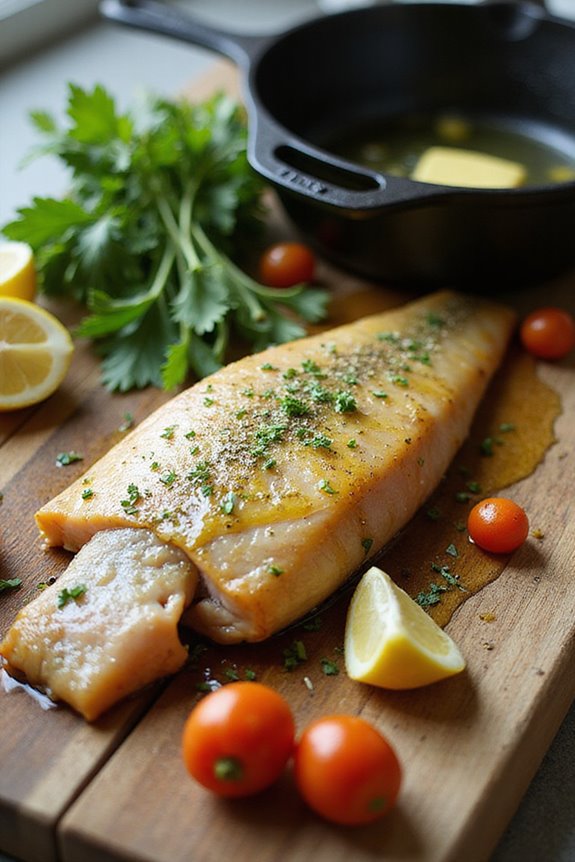
Baking mahi mahi requires a few key techniques to guarantee the fish turns out perfectly cooked and flavorful. First, I preheat the oven to between 350°F and 425°F, depending on the fillet thickness. I brush the fish with olive oil or melted butter, which helps the seasonings stick and locks in moisture. When seasoning, I use a mix of garlic powder, smoked paprika, and citrus to enhance the flavors. I make certain the fillets are spaced apart on a greased baking dish to allow even heat circulation. During baking, I monitor the fish closely to achieve a flaky texture without overcooking. Finally, I let the fish rest briefly to redistribute moisture, ensuring a juicy, tender result.
Checking Doneness and Internal Temperature
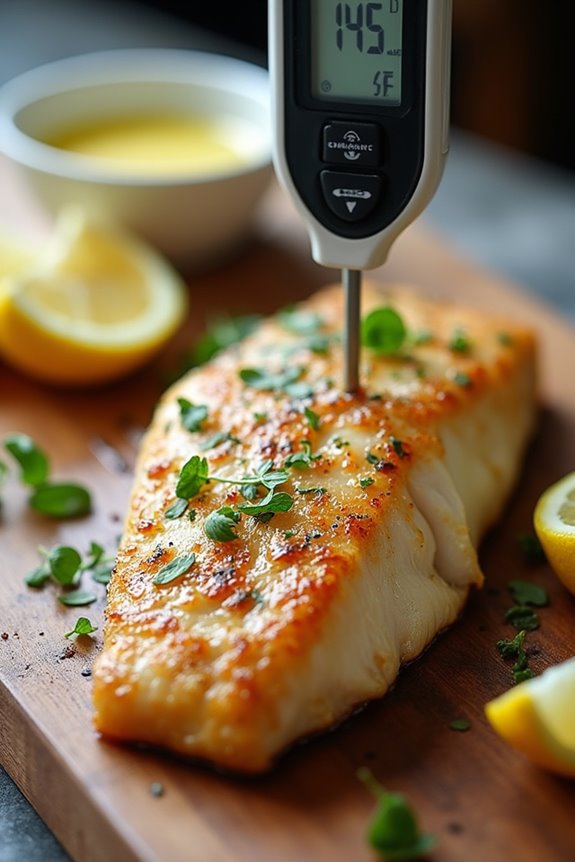
How can I guarantee my mahi mahi is cooked perfectly? To verify proper doneness, I rely on temperature nuances and doneness indicators. Mahi mahi is safe to eat when it reaches at least 137°F, but for ideal texture, I aim for 145°F. Using a calibrated meat thermometer, I insert it into the thickest part of the fillet, avoiding contact with bone or the pan. I check the temperature toward the end of baking, verifying the flesh turns opaque and flakes easily with a fork. If the surface appears golden but remains moist, it’s likely done. I also let the fish rest briefly after cooking, as carryover cooking can raise the internal temperature, solidifying the perfect cook.
Serving Suggestions and Pairings
Serving mahi mahi opens up a world of delicious pairings that enhance its mild flavor and firm texture. I recommend topping it with a fresh fruit salsa, like mango or pineapple mango, for a sweet-spicy contrast. For vegetable sides, grilled asparagus or roasted Brussels sprouts add earthy flavors. When it comes to starch options, cilantro lime rice or garlic mashed potatoes provide comforting balance. For crispy accompaniments, sweet potato fries or tempura vegetables deliver delightful texture. Finally, don’t forget sauce pairings; a zesty citrus vinaigrette or a creamy tartar sauce complements the fish beautifully. By mixing and matching these suggestions, you can create a well-rounded and satisfying meal that highlights the mahi mahi’s natural qualities.
Storing and Reheating Leftovers
When you’ve enjoyed your mahi mahi, knowing how to properly store and reheat the leftovers can make a difference in maintaining its quality. For effective leftover storage, cool the fish to 41°F (5°C) within two hours, and divide large portions into shallow containers. Once chilled, tightly cover the containers and store them on the refrigerator’s bottom shelf. Enjoy your leftovers within 3-4 days for ideal safety.
When reheating, bring the fish to an internal temperature of 165°F (74°C) for at least 15 seconds. I recommend using the oven or stovetop for reheating techniques, as they preserve flavor and texture better than the microwave. Cover the fish during reheating to guarantee even heating and prevent drying out.
Frequently Asked Questions
Where Can I Buy Fresh Mahi Mahi Fillets?
If you’re looking to buy fresh Mahi Mahi fillets, I recommend checking online seafood markets like Citarella or Key Largo Fisheries. Local markets often have fresh options too, especially those near coastal areas.
How Can I Tell if Mahi Mahi Is Fresh?
When I check mahi mahi for freshness, I rely on key indicators. It shouldn’t have a strong fish smell; instead, it should smell mild. The flesh should be firm and springy, indicating peak freshness.
Can I Use Frozen Mahi Mahi Directly Without Thawing?
Absolutely, I often use frozen mahi mahi directly without thawing! Cooking methods like baking, air frying, or pan-searing offer great recipe variations, ensuring delicious meals while preserving texture and flavor. It’s super convenient too!
What Sides Pair Well With Baked Mahi Mahi?
So, you’ve baked mahi mahi—congratulations! Now, let’s make it healthy. Think grilled asparagus or cilantro lime rice for complementary flavors. Don’t forget roasted Brussels sprouts; they add that “I’m fancy” touch. Enjoy your meal!
What Is the Best Way to Season Mahi Mahi for Grilling?
When seasoning mahi mahi for grilling, I love using a mix of olive oil, garlic powder, and paprika. These grilling marinades really enhance the flavor. Trust me, these seasoning tips make all the difference!

